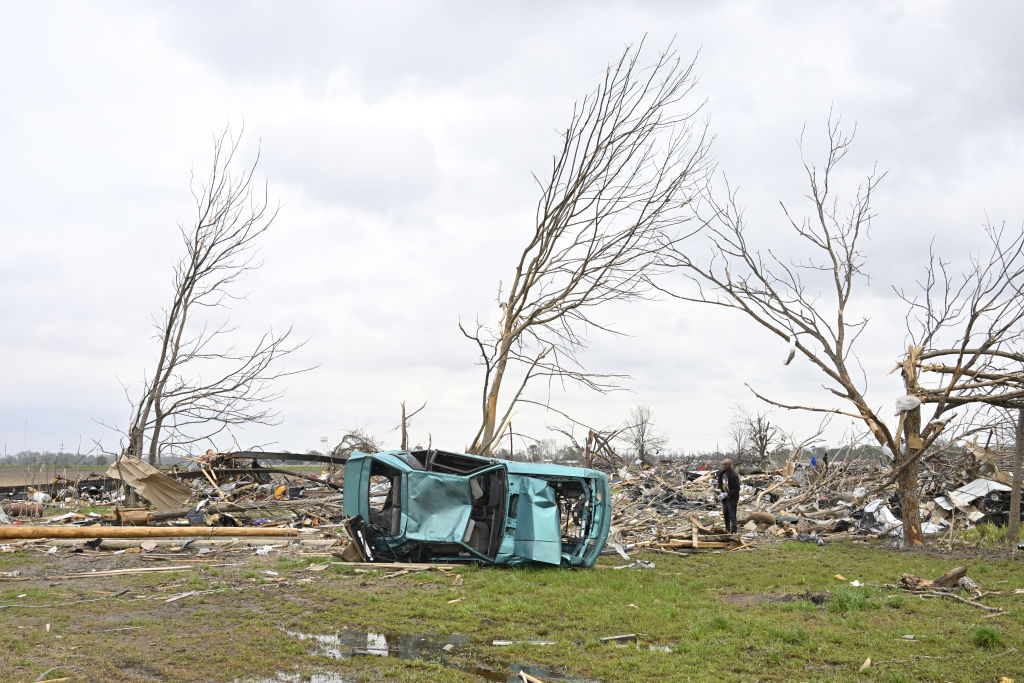
For the past two years, a group of scientists at Northern Illinois University has been trying to answer one of the trickiest questions in the field of climate modeling: will human-caused global warming bring more supercell tornado-spawning thunderstorms like the ones that killed at least 25 people in Mississippi late last month, and which killed at least 33 people across a broad swath of the South and Midwest United States over this past weekend?
Scientists already know that continued carbon pollution from fossil fuels will bring more intense heat waves, rain pattern changes that will cause drought in some areas and flooding elsewhere, and more frequent dangerous hurricanes. In recent years, increasingly powerful climate models and new statistical techniques have helped researchers leverage that knowledge into the field of attribution science, which enables scientists to determine how much humanity’s emissions contributed to particular weather events. Scientists have determined, for instance, that climate change made February’s massive rainfall and flooding in New Zealand about four times more likely. There’s even a tool that allows people to see how climate change may be impacting temperatures on a given day anywhere in the continental U.S.
But the science around climate change and supercell storms—the anvil-shaped formations that form most killer tornadoes, along with large, dangerous hail—is much less clear. Climate change is likely to bring more humidity to some hurricane regions, as well as more atmospheric instability, both essential ingredients for those big thunderstorms. But lift from rising warm air plays a big role as well, and it’s unclear how climate change would affect that, since it occurs over areas that are too small for climate models to predict. That means that researchers are still fuzzy on whether global warming will result in more supercell storms.
To get around that challenge, the researchers at Northern Illinois University used detailed weather models to simulate future storm formation on a much more localized scale, a task that took enormous amounts of time and computational power, and generated gargantuan quantities of data. “We did this for 45 years of simulations,” says Walker Ashley, a professor in the earth, atmosphere, and environment department at Northern Illinois University. “That’s 700 terabytes of data. So just the output alone is remarkable.” That’s roughly equivalent to what it would take to store 100,000 two-hour HD movies.
The results of that work were published in the Bulletin of the American Meteorological Society in January, with Walker and his co-authors concluding that a warming world will probably bring more supercell storms. That’s because, in part, more hot, dry air from the Southwest is likely to push those storms east of the central “tornado alley” region that stretches from Texas to South Dakota, instead bringing heightened risk to more densely populated states like Tennessee, Arkansas, and Mississippi, where some of the recent deadly storms have touched down.
Ashley cautions, though, that more work needs to be done in the field to help solidify those findings. “I don’t want to say that our study is the end all,” he says. “I think it’s actually the start of a broader push towards trying to understand how severe storms will change under climate change.” He also notes that climate change is only one piece of the puzzle in trying to understand what puts people in danger from killer tornadoes. A greater part of the risk, he says, has to do with development patterns in recent decades—with suburban sprawl putting more people in the path of twisters.
“[It’s] what we call the expanding bullseye,” Ashley says. “A tornado that occurred 50 years ago outside of Jackson, Mississippi, probably wouldn’t have hit much. But now the impact is far more substantial.”
More Must-Reads from TIME
- Cybersecurity Experts Are Sounding the Alarm on DOGE
- Meet the 2025 Women of the Year
- The Harsh Truth About Disability Inclusion
- Why Do More Young Adults Have Cancer?
- Colman Domingo Leads With Radical Love
- How to Get Better at Doing Things Alone
- Michelle Zauner Stares Down the Darkness
Write to Alejandro de la Garza at alejandro.delagarza@time.com